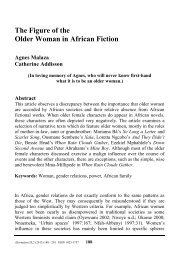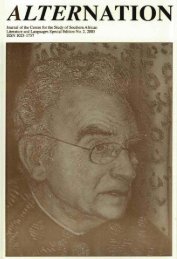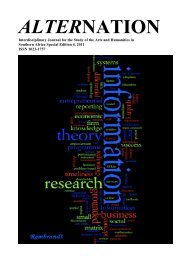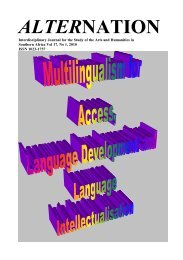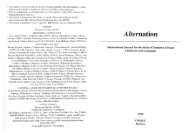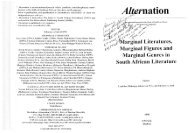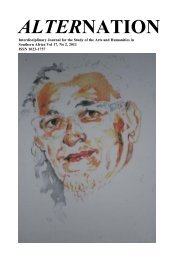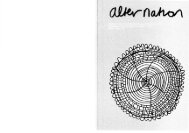Shane Moran - Alternation Journal
Shane Moran - Alternation Journal
Shane Moran - Alternation Journal
Create successful ePaper yourself
Turn your PDF publications into a flip-book with our unique Google optimized e-Paper software.
Tilo Women Critics and South African English Literavy Strcdies<br />
~vork~ngniasses inakes them rcluctalit to challenge the status quo:<br />
It rnust not be forgotten either that the Sew who contrive against great odds<br />
change, assirnilation, imitation and revolt when imitation lacks the<br />
dynamic spirit of the movement in its beginning (1944~: 12).<br />
to rise above their Scllows, hold a precarious footing hct\veen two worlds.<br />
l'hey are neitlier at one with tlieir oppressed brothers. nor are they<br />
ere Van Heyningen consistently elevated literature above politics, Taylor insisted<br />
11 the primacy ofeconomics a ~ politics d ill relation to literature. This is most vividly<br />
acceptable to the wllitc man .... They are rnol.eover apprehensive of losing<br />
~iirougl~ ally action on their part tlic little they have gained as individuals. It<br />
is an at~nosplicre fatal to the flowering of any art (1942f: 10).<br />
arent in how they understood the relationship between literature and social change.<br />
eirs is the traditional disagreement between the idealist and the dialectical<br />
ist: Van Heyningen stresses the role of ideas in historical change, and Taylor<br />
As with her al~alysis of black South African writing, so too in her understallding<br />
white South African writing, Taylor (like Trotsky) argues that art is an expression o<br />
class interests. Taylor distinguishes between William Plo~ner and Roy Ca~npbell<br />
revolutionary insurgency. Coln~ne~lting on early twentieth century attempts to<br />
Irish national sentiment by means of Celtic theatre and the work of the Gaelic<br />
ague, Taylor argues that<br />
social critique (in firrbon Wove [1925] 1985; and The Wmoo.re [I9281 197<br />
respectively) on the basis of their class affiliations. According to Taylor, Ca~npbell<br />
critique is the 'expression of contempt of the petit-bourgeois herd on the part of<br />
poetic aristocrat' (1943e:12) while Plainer's is the scepticism of the bou<br />
it is well known that revolutions cannot be made by literaly or cultural<br />
movements; the deep social discontent of the masses must supply the urge<br />
to action (1941f: 15).<br />
intellectual in the aftennath of World War 1. 'Taylor's analysis ofclass alld race in<br />
African literature is influenced by the notion prominent amongst Unity Movemen<br />
ilarly, Upton Sinclair is guilty of<br />
~nernbers of race as a construct, and 'racialism [as] a mere excrescence of capitalis<br />
(Saunders 1986:76). White South African writers, then,<br />
reflect the ideology of tlieirclass as in amirror. When they aclmit an African<br />
or a Coloured into the pages of their book in Inore tlian a decorative<br />
capacity ... they write as members of a dominant ~vhite castc looking li-om<br />
aSar at some almost sub-human species. When Ilc is not a mere victim, an<br />
over-emp]lasis[ing] the role which art plays in the social process. the<br />
function ofart a weapon of propaganda, as the maker of anew world. Art<br />
in many varied and subtle ways reflects social processes, art accompanies<br />
great historical movements and tlie study of art illulninates these. But<br />
Sinc]air was to regard art as a lever in social change. as the<br />
mighty agent ofapeacefuI revolution, as a substitute for the workers taking<br />
over by force (194%: 16).<br />
object of humanitarian pity. he is a Problem, a menace, a []ireat to wllite<br />
purity and white civilisation (1 942f: lo).<br />
e, Xylor draws on Trotsky's understanding of the relationship between literature<br />
its econoinic base. For Trotsky (echoing Hegel),<br />
A final instance of her critical method is the series of articles on fatellineteen<br />
and early twentieth-century European and American poetry published in 1944, whi<br />
resembles the kind of wide-ranging cultural and economic analysis attempted by t<br />
English Marxist Christopher Caudwell in Jllzrsion trnd Kt.ali& (1937). The series<br />
political, social and economic crises which mark European history frorn the<br />
nineteenth century are understood to have produced certain observable reactions in t<br />
the nightingale of poetry, like that bird of wisdom. the owl. is heard only<br />
after the sun has set. The day is the time for action, but at twilight feeling<br />
and reason come to take account ofwhat has been accomplisllcd.( 192553).<br />
artistic PI-oduction of the period. These she summarises as a 'tendency towards am strongly marked individualism in art, and more complete occupation of the Iv<br />
Tower' (1 944c: 13). This broad conception of artistic lnovements in relation to chang<br />
in the ecor~ornic base is qualified by a recognition, first, that artistic movement<br />
it is not possible 10 steep literature over-night in a political progralll. Itor is<br />
it desirable. Creative literature is impossible witliout a deep imaginative<br />
assimilating ofexperience (1 943a: 15).<br />
subject to their own laws of development and, second, that individual responses<br />
take differe,nt fonns:<br />
at follows from this of the relationship between literature and social<br />
Tllc development of literary (artistic) rnovelnents is ~iota si~r~plc tiring to he<br />
traced niechanically in each country it1 parallel li~ies according to the<br />
development and declillc ol'capitalist society in eacll. Wl~ile the econoniic<br />
base is an irivaluable and essential guide in tracing the rise of certain<br />
~deological concepts, literature at the saint tin~c has its own laws ofgrowkli,<br />
lor, this is to conf~~se art and politics.<br />
~~~lo~-'s to abandon the categoly of the 'literaly' pk~rsuit of<br />
litica17 art, and hel- far more nuanced understanding of the relationship between<br />
rat1ll.e and its material context did not prevent her work from being l-ccupel-ated by



